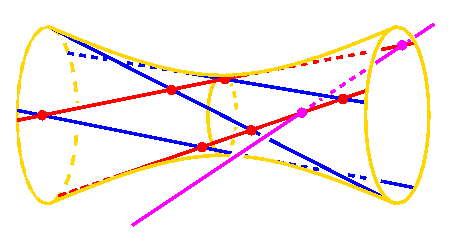Autumn 2000
Math 697R: Applicable Algebraic Geometry
Office Hours:
Tu, Th 11:30 --- 1:00 PM and by appointment.
Lectures:
Tu, Th 1:00 - 2:15 PM, LGRT 111.
Prerequisites:
Some familiarity with abstract algebra, particularly linear algebra
and rings of polynomials.
No familiarity with algebraic geometry is expected.
Text: Draft of
Applicable Algebraic Geometry,
by Sottile, J. Rosenthal, and A. Wang.
Relevant chapters will be distributed during the course, and student
input on the material is encouraged.
Notes from the course
Other books that are
available
Overview
Course Particulars
The course requirement is participation, as defined by class attendance
and two problem sessions/assignments.
Make up class
Wednesday, 25 October 2000 Early evening, place TBA
Rough Schedule
-
 Outline of 7 September.
Outline of 7 September.
-
 Outline of 19 September.
Outline of 19 September.
-
 TeX file of part of
lecture on deadbeat control on 19 September. (20-09-00).
TeX file of part of
lecture on deadbeat control on 19 September. (20-09-00).
-
 Maple file of computation in class
Output of that computation.
Maple file of computation in class
Output of that computation.
-
 TeX file concerning observability
from lecture on deadbeat control on 19 September. (21-09-00).
TeX file concerning observability
from lecture on deadbeat control on 19 September. (21-09-00).
-
 TeX file with matrix
manipulations of characteristic equation from 21 September.
(21-09-00).
TeX file with matrix
manipulations of characteristic equation from 21 September.
(21-09-00).
-
 Outline of 21 September.
Outline of 21 September.
-
 Outline of 26 September.
Outline of 26 September.
-
 TeX file describing the algebra
of polynomial matrices from 26 & 28 September.
(17-10-00).
TeX file describing the algebra
of polynomial matrices from 26 & 28 September.
(17-10-00).
-
 Outline of 28 September.
Outline of 28 September.
-
 Outline of 3 October.
Outline of 3 October.
-
 Outline of 5 October.
Outline of 5 October.
-
 Outline of 10 October.
Outline of 10 October.
-
 Outline of 12 October.
Outline of 12 October.
-
 Outline of 17 October.
Outline of 17 October.
-
 Outline of 19 October.
Outline of 19 October.
-
 Outline of 24 October.
Outline of 24 October.
-
 Outline of 25 October.
Outline of 25 October.
-
 Outline of 26 October.
Outline of 26 October.
-
 Outline of 31 October.
Outline of 31 October.
-
 Outline of 2 November.
Outline of 2 November.
-
 Outline of 7 November.
Outline of 7 November.
-
 Outline of 8 November.
Outline of 8 November.
-
 Outline of 9 November.
Outline of 9 November.
-
 Outline of 14 November.
Outline of 14 November.
-
 Outline of 16 November.
Outline of 16 November.
-
 Outline of 28 November.
Outline of 28 November.
Algebraic geometry, which is the study of solutions to systems of polynomial
equations, is important for its potential
applications---polynomial equations are ubiquitous in mathematics and the
applied sciences.
Applications often demand explicit, real-number answers and tools for this
have been developed in recent years from within algebraic geometry.
This course is concerned with complementary developments---problems
from the applied sciences whose understanding uses
algebraic geometry in an essential way.
These include problems of pole placement and stabilization (linear
systems theory) as well as matrix completion and eigenvalue inequalities
(matrix theory).
These are intended to illustrate, rather than delimit, the
range of problems for which an algebraic-geometric perspective is useful.
This course is intended to
provide a motivated and very concrete introduction to
algebraic geometry---in particular, no knowledge of algebraic geometry
is expected.
Particular attention will be paid to the real numbers and to special spaces
which have been important in applications.
 Some mathematical control theory
State-space realization
Deadbeat Control
Pole placement problem
McMillan degree
transfer functions
Coprime factorization of matrices
Some mathematical control theory
State-space realization
Deadbeat Control
Pole placement problem
McMillan degree
transfer functions
Coprime factorization of matrices
 Introduction to Affine Algebraic Geometry
The algebraic-geometric dictionary
Unique factorization for varieties
Regular and rational functions
Smooth and singular points
Introduction to Affine Algebraic Geometry
The algebraic-geometric dictionary
Unique factorization for varieties
Regular and rational functions
Smooth and singular points
 Some real and effective algebraic geometry
Real algebraic geometry
Gröbner bases
Solving systems of polynomial equations
Some real and effective algebraic geometry
Real algebraic geometry
Gröbner bases
Solving systems of polynomial equations
 Projective algebraic geometry
Subvarieties of projective space
Maps and examples of projective varieties
Central projection
Projective algebraic geometry
Subvarieties of projective space
Maps and examples of projective varieties
Central projection
 Schubert Calculus
Grassmann varieties
Schubert decompositions
Enumerative geometry
Curves in Grassmann Varieties
Schubert Calculus
Grassmann varieties
Schubert decompositions
Enumerative geometry
Curves in Grassmann Varieties
 Applications to Control Theory
Hermann-Martin curve
Constant linear feedback
pole placement; Theorem of Brockett and Byrnes
Real pole placement; Wang's Theorem
Dynamic compensators
Degree limits
Number of compensators in the critical dimension
Applications to Control Theory
Hermann-Martin curve
Constant linear feedback
pole placement; Theorem of Brockett and Byrnes
Real pole placement; Wang's Theorem
Dynamic compensators
Degree limits
Number of compensators in the critical dimension
TOP
Last modified: 31 October 2000 by Frank Sottile
 Office: LGRT 1244
Office: LGRT 1244
 Telephone: 545 - 6010
Telephone: 545 - 6010
 Home: 256 - 1223
Home: 256 - 1223
 Cell: 695 - 1574
Cell: 695 - 1574
 email: sottile@math.umass.edu
email: sottile@math.umass.edu
 WWW:
http://www.math.tamu.edu/~sottile
WWW:
http://www.math.tamu.edu/~sottile
